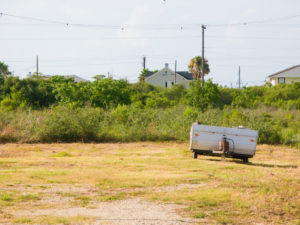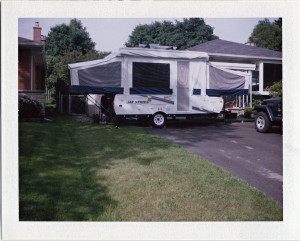Springing Your Pop Up Into Summer
If you’re like most pop up owners, you probably put any thought of camping away for the duration after winterizing your trailer some time in the fall. Although it’s definitely possible to go winter camping in a pop up, it isn’t always the most comfortable experience, and I don’t know about you, but re-winterizing a rig over and over isn’t exactly my idea of fun. But once any threat of a hard freeze is gone, all bets are off. So what if the weather isn’t going to be conducive to camping every weekend once summer is in full swing, let alone early spring—if you de-winterize your rig early on, you won’t be stuck cleaning out the cobwebs while everyone else is out enjoying themselves.
How Early is Too Early?
As the dreary winter months drag on, it’s all too easy to jump the gun on getting your rig ready for the spring thaw. So unless you really don’t mind winterizing it all over again, you’ll want to make sure that you don’t pull it off the blocks too early. But how early is too early? Exactly when should you start getting your pop up ready for spring?

The amount of work it takes to get a pop up ready for spring has a lot to do with how it spent its winter. Image courtesy of mitsy mcgoo, via Flickr (Creative Commons 2.0)
That’s basically a function of where you live and how long the winter lasts there. A good general rule of thumb is that you’re good to go once any threat of a hard freeze is gone. You’ll probably be fine if the temperature drops down near, or even below, freezing for one night, but if it drops and stays, you’re going to have to winterize your rig all over again or face the chance of some expensive repairs.
Getting Ready for Spring and Summer Camping
The exact items that you’ll have to check, perform maintenance on, or repair will depend on the type of pop up you have. For instance, tent trailer owners have to be concerned with the condition of the tent fabric, which a-frame owners won’t worry about, while pop up truck camper owners won’t have to worry about things like axle bearings and tires, assuming that they perform regular maintenance on their trucks, anyway.
To de-winterize your pop up camper, you will need to:
- Close line drains (if open)
- Check hot water tank lines for blockage
- Clear water lines, tank and filter housing of antifreeze
- Clean water lines, tank and filter housing
In general, some inspection items include:
- Exterior seals
- Vents (for blockages)
- Frame and body for damage
- Batteries for charge level and presence of corrosion
- Operation of safety alarms (i.e. smoke, carbon monoxide, etc)
- Power cord and connections
- LP system
- Tires for cracking, wear and inflation
- Presence of mildew
- Waste tank valve operation
General maintenance operations include:
- Washing the body and applying sealer or wax as appropriate
- Cleaning and applying sealers or conditioners to roof as per owner’s manual
- Seasoning as necessary
You will typically also want to lubricate items such as:
- Roof lifter posts, winches, and other raising systems
- Door hinges and locks
- Axle bearings
- Hitch and coupler

Part of getting ready for spring is setting your camper up at home to air it out and check everything over. Image courtesy of Gregory Roberts, via Flickr (Creative Commons 2.0)
Clearing Your Water Lines
The first step in getting your pop up camper ready for spring is to de-winterize it, which basically just involves getting any antifreeze out of the water lines. If you used the compressed air method, you don’t have to worry about this. Simply close up any drains you may have left open, hook up to municipal water, and you’re good to go. If the water tastes off, you may want to disinfect the system.
If you winterized with antifreeze, you will want to hook up to municipal water and clear the system. If you have a water pump, you will also want to fill your tank, unhook from the water source, turn on your pump, and run water through each faucet until to looks clear and doesn’t have any funny taste. If you used nontoxic RV/marine antifreeze, ingesting a trace amount will not hurt you.
Disinfecting a Pop Up Camper Water System
After you have removed any trace of antifreeze, you may want to disinfect your water system. This is a good idea to do at least once a year in any case, just to make sure that harmful—or bad-tasting—microbes don’t take hold your RV’s water tank. Molds can be very dangerous, so you want to make sure that you don’t end up drinking any water that contains spores.
To disinfect your water system, you will want to add roughly one cup of bleach to your tank. If your tank holds more than 20 gallons, which is rare in pop ups, you will have to use a little more. You will then want to run each faucet and shower head in your camper long enough for the bleach/water solution to reach it, and then wait for about two hours. If you wait longer, the bleach may damage seals in the lines and water pump.
After about two hours, you will want to completely flush the system. You can do this any way you like, but the fastest way is to simply drain your fresh water tank, if it has a drain, and then run clean water through the lines until the bleach/water solution is gone. You will then want to dump your waste water tank, which is a good time to check the operation of the knife valves as well.
Seasoning Your Pop Up Camper
If you have a new pop up camper, and you’re getting it ready for its first trip, you will also have to season the tent fabric before you head out. Most manufacturers that recommend seasoning suggest that you do so four times before your first trip, so make sure to allow enough time. This is a simple process of setting the camper up, soaking the tent portions with a garden hose, and allowing them to dry. This process should be performed a total of four times.
Inspecting and Caring For Tent Trailer Fabric
If you cleaned your trailer, and you allowed it to fully dry, before folding it up for the winter, the fabric should still be in good shape when you take it out in the spring. A good rule of thumb is to rinse the fabric off once each month when it is in use and to clean it when it gets dirty. You can go ahead and rinse it off when getting your camper ready for spring, and then schedule a a regular light cleaning each month thereafter.
If the tent fabric does need to be cleaned, then you will want to start by scrubbing it thoroughly with a soft brush and warm, soapy water. If you have acrylic fabric, you can use a stiffer brush, but you will still want to use warm, soapy water. In either case, rinse the fabric off when you are done and allow it to dry fully before folding the camper back up.
Inspecting Your Pop Up Camper for Mildew
Mildew can be a big problem in pop up campers, especially when you put them away without allowing the tent fabric to dry fully. It’s less of an issue if you have polyester fabric with a vinyl coating, which is mildew resistant, but the right conditions can still allow mildew to grow.
If you detect the presence of mildew, rinse, scrub, and clean the awning as needed, and avoid folding the camper up until it is totally dry. You will want to inspect for mildew regularly thereafter, and you may need to clean your tent fabric more often if the local environmental conditions are conducive to mildew growth.
